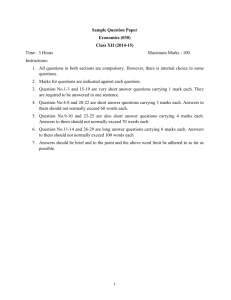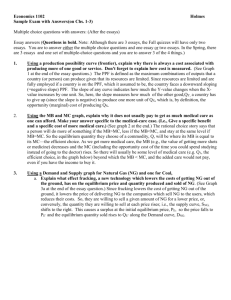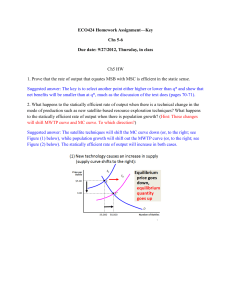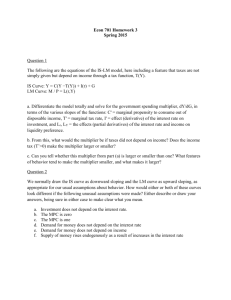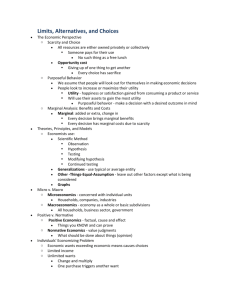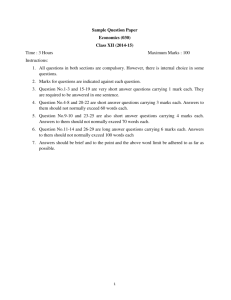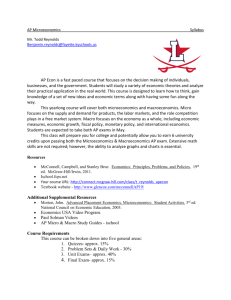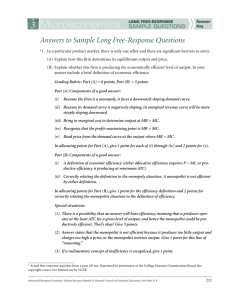Exam #1 Economics 2113 Principles Microeconomics Dr. Philip
advertisement
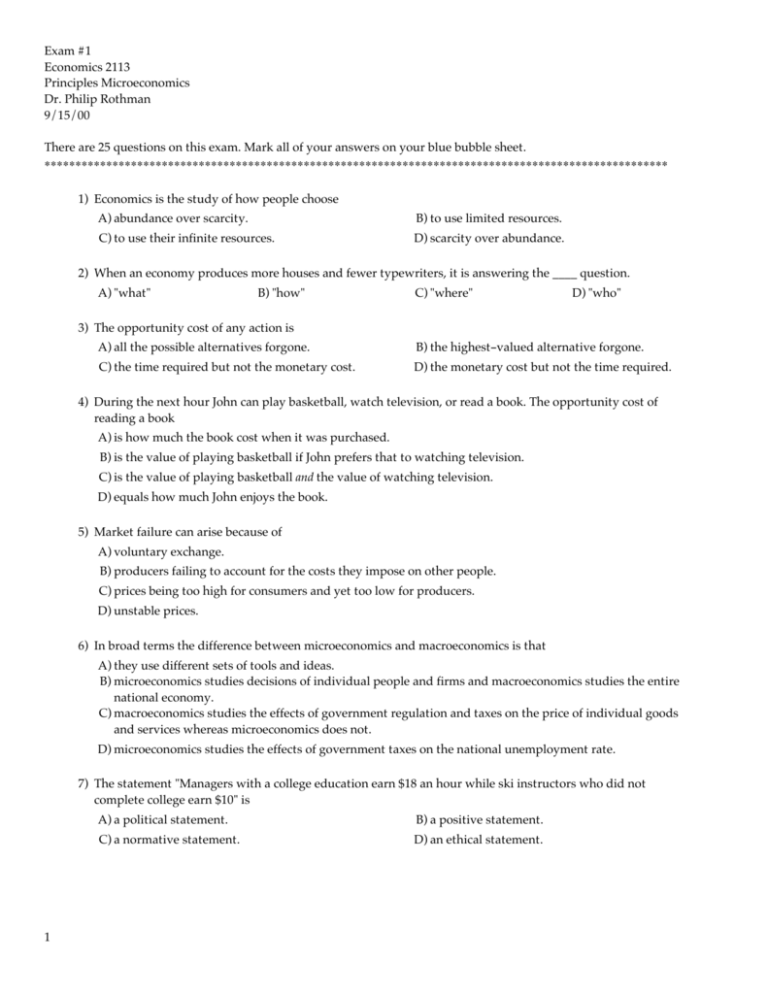
Exam #1 Economics 2113 Principles Microeconomics Dr. Philip Rothman 9/15/00 There are 25 questions on this exam. Mark all of your answers on your blue bubble sheet. ***************************************************************************************************** 1) Economics is the study of how people choose A) abundance over scarcity. B) to use limited resources. C) to use their infinite resources. D) scarcity over abundance. 2) When an economy produces more houses and fewer typewriters, it is answering the ____ question. A) "what" B) "how" C) "where" D) "who" 3) The opportunity cost of any action is A) all the possible alternatives forgone. B) the highest-valued alternative forgone. C) the time required but not the monetary cost. D) the monetary cost but not the time required. 4) During the next hour John can play basketball, watch television, or read a book. The opportunity cost of reading a book A) is how much the book cost when it was purchased. B) is the value of playing basketball if John prefers that to watching television. C) is the value of playing basketball and the value of watching television. D) equals how much John enjoys the book. 5) Market failure can arise because of A) voluntary exchange. B) producers failing to account for the costs they impose on other people. C) prices being too high for consumers and yet too low for producers. D) unstable prices. 6) In broad terms the difference between microeconomics and macroeconomics is that A) they use different sets of tools and ideas. B) microeconomics studies decisions of individual people and firms and macroeconomics studies the entire national economy. C) macroeconomics studies the effects of government regulation and taxes on the price of individual goods and services whereas microeconomics does not. D) microeconomics studies the effects of government taxes on the national unemployment rate. 7) The statement "Managers with a college education earn $18 an hour while ski instructors who did not complete college earn $10" is 1 A) a political statement. B) a positive statement. C) a normative statement. D) an ethical statement. 8) Statements about what ought to be are called A) positive statements. B) normative statements. C) assumptions. D) implications. 9) Human capital is A) all capital owned by individuals, but not by corporations or governments. B) all capital owned by individuals or corporations, but not by governments. C) machinery that meets or exceeds federal safety standards for use by humans. D) the accumulated skill and knowledge of workers. 10) The production possibility frontier A) refers to the technology used in such goods as computers and military aircraft. B) once applied to U.S. technology but now refers to Japanese technology. C) marks the boundary between attainable combinations of goods and services and unattainable combinations. D) is also called the supply curve. 11) Sam's production possibility frontier has good A on the horizontal axis and good B on the vertical axis. If Sam is producing at a point inside his frontier, then he A) can increase production of both goods with no increase in resources. B) is fully using all his resources. C) values good A more than good B. D) values good B more than good A. 12) Refer to the production possibility frontier in the figure above. Which point is unattainable? A) Point a. B) Point b. C) Point c. D) Point e. 13) If additional units of a good could be produced at a constant opportunity cost, the production possibility frontier would be A) bowed outward. 2 B) bowed inward. C) positively sloped. D) a straight line. 14) Jane produces only corn, measured in tons, and cloth, measured in bolts. For her, the opportunity cost of one more ton of corn is A) the same as the opportunity cost of one more bolt of cloth. B) the inverse of the opportunity cost of one more bolt of cloth. C) the ratio of all the bolts of cloth she produces to all the tons of corn she produces. D) the ratio of the acres of land she uses to graze sheep to the acres she uses to grow corn. 15) In the above figure, if 2 million computers are produced per year then the A) marginal cost of a computer exceeds the marginal benefit of a computer, so more computers should be produced. B) marginal cost of a computer exceeds the marginal benefit of a computer, so fewer computers should be produced. C) marginal benefit of a computer exceeds the marginal cost of a computer, so more computers should be produced. D) marginal benefit of a computer exceeds the marginal cost of a computer, so fewer computers should be produced. 16) The production possibilities frontier in illustrated in the figure above will shift outward the most rapidly if point A) A is selected. 3 B) B is selected. C) C is selected. D) D is selected. 17) A relative price is A) the slope of the demand curve. B) the difference between one price and another. C) the slope of the supply curve. D) the ratio of one price to another. 18) The quantity demanded is A) always equal to the equilibrium quantity. B) independent of the price of the good. C) the amount of a good that consumers plan to purchase at a particular price. D) independent of consumers' buying plans. 19) The law of demand implies that, other things remaining the same, A) as the price of a cheeseburger rises, the quantity of cheeseburgers demanded will increase. B) as the price of a cheeseburger rises, the quantity of cheeseburgers demanded will decrease. C) as income increases, the quantity of cheeseburgers demanded will increase. D) as the demand for cheeseburgers increases, the price of a cheeseburger will fall. 20) If income increases or the price of a complement falls, A) the demand curve for a normal good shifts leftward. B) the demand curve for a normal good shifts rightward. C) the supply curve of a normal good shifts leftward. D) the supply curve of a normal good shifts rightward. 21) Inferior goods are those for which demand increases as A) the price of a substitute falls. B) the price of a substitute rises. C) income decreases. D) income increases. 22) A fall in the price of a good causes producers to reduce the quantity of the good they are willing to produce. This fact illustrates A) the law of supply. B) the law of demand. C) a change in supply. D) the nature of an inferior good. 23) Which of the following does NOT shift the supply curve? A) A technological advance. B) A decrease in the wages of labor used in production of the good. C) A fall in the price of a substitute in production. D) An increase in the price of the good. 4 24) In the above figure, if the demand curve is D2, then A) the equilibrium price will be P1 and the equilibrium quantity will be Q2. B) the equilibrium price will be P1 and the equilibrium quantity will be Q1. C) there will be a shortage equal to Q2 - Q1. D) an increase in price will cause the demand curve to shift to D3. 25) When the demand for a good decreases, its equilibrium price ____ and equilibrium quantity ____. A) falls; decreases 5 B) falls; increases C) rises; decreases D) rises; increases Answer Key Testname: 2113E1F00 1) Answer: B 2) Answer: A 3) Answer: B 4) Answer: B 5) Answer: B 6) Answer: B 7) Answer: B 8) Answer: B 9) Answer: D 10) Answer: C 11) Answer: A 12) Answer: D 13) Answer: D 14) Answer: B 15) Answer: C 16) Answer: C 17) Answer: D 18) Answer: C 19) Answer: B 20) Answer: B 21) Answer: C 22) Answer: A 23) Answer: D 24) Answer: A 25) Answer: A 1


